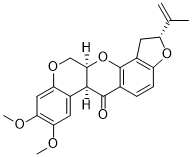All AbMole products are for research use only, cannot be used for human consumption.

In vitro: Mitogen Activated Protein Kinase (MAPK), Toll-like receptor, Wnt, and Ras signaling pathways are intensively involved in the effect of rotenone on the ENS. Rotenone-induced cell death is reduced as measured by decline in the levels of pro-apoptotic proteins.
In vivo: Rotenone causes a significant increase in the excitatory amino acid neurotransmitters; glutamate and aspartate together with a significant decrease in the inhibitory amino acids, GABA, glycine and taurine are observed in the cerebellum of rat model of PD. Rotenone (1.5, 2, or 2.5 mg/kg) causes a dose-dependent increase in α-synuclein in the substantia nigra. Furthermore, at 2 and 2.5 mg/kg, rotenone causes a significant decrease in the number of tyrosine hydroxylase-immunoreactive neurons in the substantia nigra, and dopamine in the striatum in rats.

Front Microbiol. 2024 Feb 21;15:1358525.
Electroacupuncture at ST25 corrected gut microbial dysbiosis and SNpc lipid peroxidation in Parkinson's disease rats
Rotenone purchased from AbMole

Cell Cycle. 2023 May 9;1-15.
The effect of ROS-YAP crosstalk on osteoimmune response orchestrating osteogenesis
Rotenone purchased from AbMole

Front Neurol. 2023 Jan 11;13:1092127.
Parkinson's disease constipation effect of electroacupuncture at ST25 through colonic motility and enteric neuropathology
Rotenone purchased from AbMole

Anat Rec (Hoboken). 2023 Jan 19.
The effect of electroacupuncture at ST25 on Parkinson's disease constipation through regulation of autophagy in the enteric nervous system
Rotenone purchased from AbMole

Redox Biol. 2020 Oct;37:101761.
Stat2-Drp1 mediated mitochondrial mass increase is necessary for pro-inflammatory differentiation of macrophages
Rotenone purchased from AbMole
| Cell Experiment | |
|---|---|
| Cell lines | PC12 cells |
| Preparation method | For cell or brain tissue exposure, rotenone stock solutions were diluted with PBS to obtain a final solution of 1m DMSO. PC12 cells were exposed to rotenone or the corresponding solvent for different times. |
| Concentrations | 10 μM |
| Incubation time | 48 h |
| Animal Experiment | |
|---|---|
| Animal models | adult male Sprague–Dawley rats |
| Formulation | DMSO |
| Dosages | 12 μg/rat |
| Administration | i.v. |
| Molecular Weight | 394.42 |
| Formula | C23H22O6 |
| CAS Number | 83-79-4 |
| Solubility (25°C) | DMSO ≥ 30 mg/mL |
| Storage | 2-8°C, sealed |
| Related Animal Modeling Products |
|---|
| Sodium Thioglycolate
Sodium thioglycolate acts as reducing agent and is suitable for anaerobic and microaerophilic bacterial growth. Sodium thioglycolate is a commonly used reagent for bacteriological research to maintain reducing conditions in media. Thioglycolate can also protect enzymes against inactivation by maintaining protein thiol groups in the reduced state. Thioglycolate medium is frequently used in inflammation research to elicit a neutrophil and macrophage response in vivo. |
| Vancomycin-d10 2TFA salt
Vancomycin-d10 2TFA salt |
| Acetic acid-d4
Acetic acid-d4 |
| Myosin H Chain Fragment, mouse acetate
Myosin H Chain Fragment, mouse acetate salt is a fragment of the α-Myosin heavy chain peptide. Myosin H Chain Fragment can be used to induce experimental autoimmune myocarditis (EAM) mouse model. |
| Myosin H Chain Fragment, mouse
Myosin H Chain Fragment, mouse is a fragment of the α-Myosin heavy chain peptide. Myosin H Chain Fragment can be used to induce experimental autoimmune myocarditis (EAM) mouse model. |
All AbMole products are for research use only, cannot be used for human consumption or veterinary use. We do not provide products or services to individuals. Please comply with the intended use and do not use AbMole products for any other purpose.


Products are for research use only. Not for human use. We do not sell to patients.
© Copyright 2010-2024 AbMole BioScience. All Rights Reserved.
